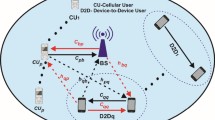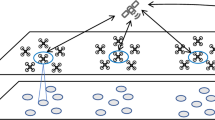Abstract
Cooperative communication could enhance the performance of wireless communications by allowing nodes to cooperate with each other to provide spatial diversity gain. In cooperative communications, rational helper selection is an important issue to obtain good cooperative gain at destinations. There are many works on this topic; however, most of them are based on hop-by-hop model and few works investigate how to select helpers for the nodes in a multi-hop path to optimize the end-to-end performance. The helper selection for one node could affect the helper selection for other nodes on the same route and in turn affect end-to-end performance. In other words, the traditional hop-by-hop helper selection methods could not lead to optimal performance in multi-hop environments. To solve this, this paper firstly defines a novel cooperation mode, named segment cooperation, and deduces the capacity and outage probability of cooperation segment. Then new performance metrics, end-to-end capacity and end-to-end outage probability, are defined to measure the end-to-end performance of multi-hop route. Finally, a segment cooperation method is proposed to maximize these metrics.










Similar content being viewed by others
References
Nosratinia, A., Hunter, T. E., & Hedayat, A. (2004). Cooperative communication in wireless networks. IEEE Communications Magazine, 42(1), 74–80.
Sendonaris, A., Erkip, E., & Aazhang, B. (2003). User cooperation diversity—Part I: System description. IEEE Transactions on Communications, 51(11), 1927–1938.
Laneman, J., Tse, D., & Wornell, G. (2004). Cooperative diversity in wireless networks: Efficient protocols and outage behavior. IEEE Transactions on Information Theory, 50(12), 3062–3080.
Cover, T., & El-Gamal, A. (1979). Capacity theorems for the relay channel. IEEE Transactions Information Theory, 25(5), 572–584.
Khojasterpour, M. A., Sabharwal, A., & Aazhang, B. (2003). On the capacity of ‘cheap’ relay networks. In Proceedings of the conference information sciences and systems, Baltimore, MD, March 2003.
Hunter, T., & Nosratinia, A. (2006). Diversity through coded cooperation. IEEE Transactions on Wireless Communications, 5(2), 283–289.
Wang, B., Han, Z., & Liu, K. J. R. (2007). Distributed relay selection and power control for multiuser cooperative communication networks using buyer/seller game. In INFOCOM 2007, May 2007, pp. 544–552.
Chu, J. P. K., Adve, R. S. & Eckford, A. W. (2007). Relay selection for low-complexity coded cooperation. In IEEE GLOBECOM ’07, November 2007, pp. 3932–3936.
Zhao, Y., Adve, R., & Lim, T. J. (2006). Improving amplify-and-forward relay networks: Optimal power allocation versus selection. In IEEE international symposium on information theory, July 2006, pp. 1234–1238.
Nagaraj, S., Truhachev, D. & Schlegel, C. (2006). Achievable communication rates in ad hoc wireless networks using local node cooperation. In IEEE international conference on communications, June 2006, pp. 4052–4058.
Ge, Y., Wen, S., & Ang, Y.–H. (2009). Analysis of optimal relay selection in IEEE 802.16 multihop relay networks. In IEEE wireless communications and networking.
Zhang, Y., Xu, Y., & Cai, Y. (2008). Relay selection utilizing power control for decode-and-forward wireless relay networks. In 2nd international conference on signal processing and communication systems, December 2008, pp. 1–5.
Huang, J., Han, Z., Chiang, M., & Poor, H. V. (2008). Auction-based resource allocation for cooperative communications. IEEE Journal on Selected Areas in Communications, 26(7), 1226–1237.
Zhou, Z., Zhou, S., Cui, J.-H. & Cui, S. (2007). Energy-efficient cooperative communication based on power control and selective relay in wireless sensor networks. In IEEE military communications conference, October 2007, pp. 1–7.
Srinivasan, V., Nuggehalli, P., Chiasserini, C. F., & Rao, R. R. (2003). Cooperation in wireless ad hoc networks. In INFOCOM 2003, April 2003, pp. 808–817.
Ban, T. W., Jung, B. C., Sung, D. K., & Choi, W. (2007). Performance analysis of two relay selection schemes for cooperative diversity. In IEEE 18th international symposium on personal, indoor and mobile radio communications, September 2007, pp. 1–5.
Wang, C.-L., & Syue, S.-J. (2009). An efficient relay selection protocol for cooperative wireless sensor networks. In IEEE wireless communications and networking conference, April 2009, pp. 1–5.
Tam, W. P. Lok, T. M., & Wong, T. F. (2008). Flow-optimized asynchronous relay selection protocol for parallel relay networks. In IEEE international conference on communications, May 2008, pp. 1024–1028.
Bahrami, H. R. Le-Ngoc, T. (2007). Relay selection and distributed BLAST in multi-antenna cooperative networks. In IEEE global telecommunications conference, November 2007, pp. 3442–3446.
Khandani, A., Abounadi, J., Modiano, E., & Zheng, L. (2007). Cooperative routing in static wireless networks. IEEE Transactions on Communications, 55(11), 2185–2192.
Zhang, J., & Zhang, Q. (2008). Cooperative routing in multi-source multi-destination multi-hop wireless networks. In IEEE INFOCOM, pp. 306–310.
Huang, X., Zhai, H., & Fang, Y. (2008). Robust cooperative routing protocol in mobile wireless sensor networks. IEEE Transactions On Wireless Communications, 7(12), 5278–5285.
Savazzi, S., & Spagnolini, U. (2007). Energy aware power allocation strate-gies for multihop cooperative transmission schemes. IEEE Journal on Selected Areas in Communication, 25(2), 318–327.
Li, Y., Cao, B., Wang, C., & You, X. (2009). Dynamical cooperative mac based on optimal selection of multiple helpers. Hawaii, USA: IEEE Globecom.
Acknowledgment
The authors would like to thank the anonymous reviewers and editor for their valuable comments and suggestions. And thank the support by the National Science Foundation of China (61071118, 60702055), Natural Science Foundation Project of CQ CSTC.
Author information
Authors and Affiliations
Corresponding author
Rights and permissions
About this article
Cite this article
Li, Y., Wang, C., Wang, R. et al. Segment cooperation communication in multi-hop wireless networks. Wireless Netw 18, 827–836 (2012). https://doi.org/10.1007/s11276-012-0436-1
Published:
Issue Date:
DOI: https://doi.org/10.1007/s11276-012-0436-1




